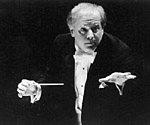THE SUBTEXT, or “theme,” that conductor Adam Stern used to program the Seattle Symphony’s October 22 “Music of Our Time” concert was terrifically rewarding, especially as far as 20th-century music is concerned: He simply chose works he loved and wanted to share. Since the pieces dated from 1928 to 1971, “of our time” isn’t exactly truth in advertising. But, consciously or not, the eclectic lineup of six works also ended up being a pretty good pr飩s and overview of the waning century’s musical trends.
Seattle Symphony
Benaroya Recital Hall, October 22
National Symphony
Benaroya Hall, October 23
South African composer Priaulx Rainier’s Sinfonia da Camera (1947), a vigorous, angular work, featured astringent Hindemith-meets-Bartok harmonies with just a glint of steel in them. Musical contrast within movements was not a preoccupation of Rainier’s here, however; the first movement sounded fresh, but the sighing, wandering slow movement, the edgily skittering scherzo, and the even edgier finale all overstayed their welcome.
If any corner of the repertory has been musica non grata at the SSO, it’s postwar European music. Gy� Ligeti’s Ramifications (the quintessential ’60s title, except it lacks a Roman numeral) is exactly the sort of piece I never dreamed I’d hear at Benaroya. Tiny oscillations, tremolos, harmonics, and bow ricochets from every string player coalesce into a sonic whole that slowly pulses, breathes, thins, and thickens—an organic motion that by no means precludes drama or even lyricism. (Considering the piece dates from 1968, the metaphor that first comes to mind is the gentle ooze of a lava lamp.) Andr頂oucourechliev’s Ombres (1970) for 12 strings was a similar sort of tone-cloud piece, made from sustained gray sounds shot through with heavily altered Beethoven quotes (not that they were recognizable as such; I just read that in the program notes). In two improvisatory interludes, the players chose at whim from a page of given phrase fragments. It was a long, flabby, nonurgent piece, especially compared with the Ligeti; Boucourechliev was less concerned with (or had less control over) the shape and movement of the overall sound.
One hundred and eighty degrees from these was the concert’s finale, dessert in three movements under the title Folk Song Suite (1945) by Gail Kubik. This piece was helped by its context—immediately following Ombres, I was ready for some good clean primary-color orchestration and toe-tapping rhythms. On a standard symphony program, the Suite‘s cute ‘n’ complacent Americanisms would probably have driven me up the wall.
Another work incorporating musical quotations, which with Ombres made up the “postmodernism” segment of the program, was Gavin Bryars’ Jesus’ Blood Never Failed Me Yet. Bryars recorded a short stanza from a gospel hymn sung by a London homeless person in a cracked voice and made a tape loop out if it. (The piece can thus run as long as the musicians like, depending on how long they let the loop run; this realization lasted about 20 minutes.) Under this the orchestra plays a slow chord progression that more or less harmonizes with the hymn tune, though the conductor is given the freedom to push the orchestra ahead out of sync with the voice or pull it back. The chord progression opens and closes with just a few wisps of strings; the rest of the orchestra gradually enters and then drops out, making a big arch shape. The result is overwhelmingly beautiful—sweet, charming, and prayerful; as one audience member pointed out in the discussion following the concert, repetition has always been part and parcel of religious observance and ritual.
LEONARD SLATKIN, in his Benaroya appearance with his National Symphony, struck me as a composer’s dream conductor; everything put on the page can be heard, making exactly the intended effect. What a joy it must have been for William Bolcom to write his Sixth Symphony for Slatkin and the NSO on their commission. The work is a perfect example of Bolcom’s role as the current patron saint of nondoctrinaire composition. His style embraces, with splendid success, boldly colored lyrical dissonance; a slow foxtrot (an actual tune borrowed from Vincent “Tea for Two” Youmans), complete with a wire-brush-on-the-trap-set backbeat; and strict 12-tone devices (the luscious moody cello phrase that opened and closed the first of the four movements).
It was thrilling to hear Aaron Copland’s ascent from the amazing self-assurance shown in the prelude from his First Symphony, heard the night before at “Music of Our Time,” to the added depth and power of his Third Symphony, his compositional zenith and the centerpiece of the NSO concert. Barber’s Second Essay, Gershwin’s An American in Paris, and (as encore) Bernstein’s Candide Overture also all received spectacular performances—dazzlingly played, affectionately conducted. Like Stern’s, Slatkin’s program showed that evangelical conviction in the music is the most vital ingredient for a memorable concert.







